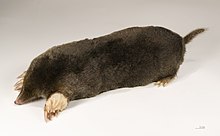鼹鼠:修订间差异
删除的内容 添加的内容
Wangxuan8331800(留言 | 贡献) 小 Substanced {{PAGENAME}}由自动维基浏览器协助 (8414) |
改重定向爲條目 |
||
| 第1行: | 第1行: | ||
{{not|鼴科|鼴形鼠科}} |
|||
'''鼹鼠'''可以指: |
|||
{{Taxobox |
|||
* '''[[鼴科]]''',又稱'''鼴鼠科'''的動物。 |
|||
| name = Moles |
|||
* '''[[鼴形鼠科]]''',又稱'''瞎鼠科'''的動物,有時也被人稱為「鼴鼠」,但上項才是真正的鼴鼠。 |
|||
| image = Talpa europaea MHNT.jpg |
|||
| image_caption = {{link-en|歐洲鼴鼠|European mole}} |
|||
| regnum = [[動物]] |
|||
| phylum = [[脊索動物]] |
|||
| classis = [[哺乳動物]] |
|||
| infraclassis = [[真獸下綱]] |
|||
| ordo = {{link-en|真盲缺大目|Eulipotyphla}} |
|||
| familia = [[鼴科]] |
|||
| familia_authority = |
|||
| subdivision_ranks = |
|||
| subdivision = |
|||
}} |
|||
'''鼴鼠'''一種是適應穴居生活的小型哺乳動物,具有圓柱形身軀、柔軟的毛皮、極小的耳目、退化的後腿與短且大的有力前肢用以挖掘土壤<ref>{{cite journal |doi=10.1371/journal.pone.0011810 |title=Light Perception in Two Strictly Subterranean Rodents: Life in the Dark or Blue? |year=2010 |editor1-last=Iwaniuk |editor1-first=Andrew |last1=Kott |first1=Ondřej |last2=Sumbera |first2=Radim |last3=Nemec |first3=Pavel |journal=PLoS ONE |volume=5 |issue=7 |pages=e11810 |pmid=20676369 |pmc=2911378}}</ref>。 |
|||
英文當中的「mole」通常指{{link-en|真盲缺大目|Eulipotyphla}}[[鼴科]]當中見於[[北美洲]]<ref>{{cite web |url=http://home.cc.umanitoba.ca/~campbelk/moledistribution.html |accessdate=11 March 2010 |title=Mole Distribution Maps |author=Campbell, Kevin |publisher=University of Manitoba}}</ref>、[[亞洲]]與[[歐洲]]的鼴鼠,儘管有時此詞也涵蓋了一些澳大利亞與[[非洲]]南部完全與鼴鼠無關但軀體卻在進化當中變得與鼴鼠相似的哺乳動物。包括{{link-en|食蟲水棲鼴鼠|desman}}與[[鼩鼴]]在内的一些鼴科動物由於身形并不接近而不被汎指爲鼴鼠。 |
|||
{{消歧義|cat=二字物種消歧義}} |
|||
==參考資料== |
|||
{{reflist}} |
|||
{{動物小作品}} |
|||
2017年7月9日 (日) 00:39的版本
| Moles | ||||||||||||
|---|---|---|---|---|---|---|---|---|---|---|---|---|
 | ||||||||||||
| 科學分類 | ||||||||||||
|
鼴鼠一種是適應穴居生活的小型哺乳動物,具有圓柱形身軀、柔軟的毛皮、極小的耳目、退化的後腿與短且大的有力前肢用以挖掘土壤[1]。
英文當中的「mole」通常指真盲缺大目鼴科當中見於北美洲[2]、亞洲與歐洲的鼴鼠,儘管有時此詞也涵蓋了一些澳大利亞與非洲南部完全與鼴鼠無關但軀體卻在進化當中變得與鼴鼠相似的哺乳動物。包括食蟲水棲鼴鼠與鼩鼴在内的一些鼴科動物由於身形并不接近而不被汎指爲鼴鼠。
參考資料
- ^ Kott, Ondřej; Sumbera, Radim; Nemec, Pavel. Iwaniuk, Andrew , 编. Light Perception in Two Strictly Subterranean Rodents: Life in the Dark or Blue?. PLoS ONE. 2010, 5 (7): e11810. PMC 2911378
 . PMID 20676369. doi:10.1371/journal.pone.0011810.
. PMID 20676369. doi:10.1371/journal.pone.0011810.
- ^ Campbell, Kevin. Mole Distribution Maps. University of Manitoba. [11 March 2010].
| 这是一篇與动物相關的小作品。你可以通过编辑或修订扩充其内容。 |
